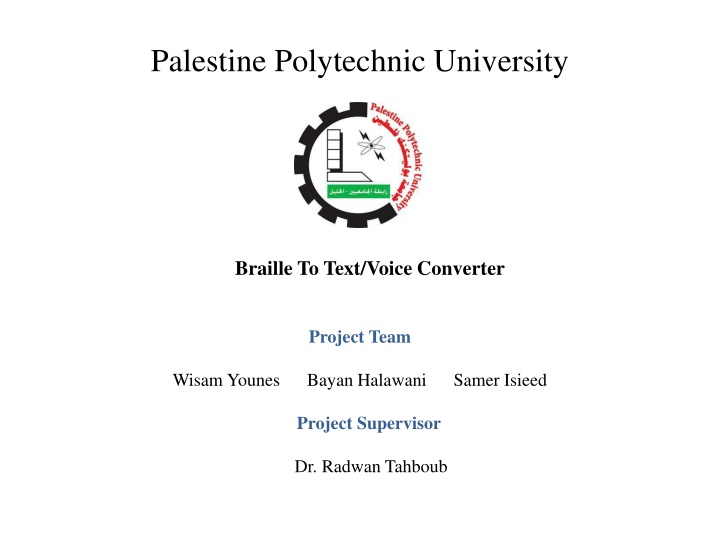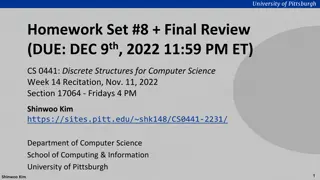
Palestine Polytechnic University Braille Text/Voice Converter Project
"The Palestine Polytechnic University team is developing a Braille text/voice converter system to bridge the gap between blind and sighted individuals. This innovative project aims to translate Braille script into multilingual text or voice, enhancing accessibility and education for visually impaired individuals."
Download Presentation

Please find below an Image/Link to download the presentation.
The content on the website is provided AS IS for your information and personal use only. It may not be sold, licensed, or shared on other websites without obtaining consent from the author. If you encounter any issues during the download, it is possible that the publisher has removed the file from their server.
You are allowed to download the files provided on this website for personal or commercial use, subject to the condition that they are used lawfully. All files are the property of their respective owners.
The content on the website is provided AS IS for your information and personal use only. It may not be sold, licensed, or shared on other websites without obtaining consent from the author.
E N D
Presentation Transcript
Palestine Polytechnic University Braille To Text/Voice Converter Project Team Wisam Younes Bayan Halawani Samer Isieed Project Supervisor Dr. Radwan Tahboub
Outline Abstract Project Objectives About Braille (Briefly) Conceptual Block Diagram Braille Paper Image Processing Technique Suggested Algorithm For Skewed Image BT/VC Algorithm Cell/Dot Recognition Use Cases Sequence Diagram Results Conclusion Future Work
Abstract The Braille to Text/Voice Converter (BT/VC) is a system that designed to help sighted people to be able to understand Braille script without any knowledge in Braille. The aim of this project is to develop a system that is able to translate a Braille script into multilingual script and represents the converted script as text or voice to the user using mobile application.
Project Objectives Reduce the gap between blind and sighted people. Help teachers to teach blind students. Help the parents to keep track of their blind child s study. Design a system that is portable, flexible and easy to use.
About Braille Braille is a language that is used to read and write by blind people. Founded by LouisBraille Braille cell Grade 1
Image Processing Techniques Converting image from RGB to Gray scale. Separate the dots from the background. Enhance the image using Morphology techniques.
RGB to Gray Scale Image RGB Gray Scale
Separate the Dots From the Background Done using adaptive thresholding . Changes the threshold dynamically over the image
Morphology Technique. Dilation Erosion
Suggested Algorithm for Skewed Images A suggested solution for this problem is to find the sum of rows on a Braille cell, after that the image is rotated with a small angle
Xd BT/VC Algorithm w Left top corner(x,y) 1 1 1 1 1 4 4 4 CenterX =x+ 0.5*w. CenterY =y+ 0.5*h. hw=0.5*w - d. hh=0.5*h - d. 2 2 5 5 2 5 h Yd 3 3 6 6 3 6 Dot1: (centerX-hw,centerY-hh) Dot2 : (centerX-hw,centerY) Dot3 : (centerX-hw,centerY+hh) Dot4: (centerX+hw,centerY-hh) Dot5: (centerX+hw,centerY) Dot6: (centerX+hw,centerY+hh) 1 1 4 2 5 3 6
Cell/Dot Recognition After we applied the previous algorithm, we got the following sample : Consider we have these three cells Export a binary code for each one. Cell 1 : 111010. Cell 2 : 101001. Cell 3 : 010100. Then using the Hash table we can get the ASCII Code for each of the previous binary code
Use Case Diagram User Buy SmartDraw!- purchased copies print this document without a watermark . Visit www.smartdraw.com or call 1-800-768-3729.
Results According to the three Braille samples that have been tested in different situations using BT/VC algorithm. The following table shows the results that have been recorded during testing stage. Sample Skew Algorithm Ideal Image Ordinary Scanned Sparse Data State Average(%) 99.6 59.3 66 78.3 94
Conclusion Dealing with images in term of image processing issue it is not an easy task. Braille image is a sensitive image, which means it should be captured under a suitable situation in order to get a good results. It is possible to program an application for android using C# instead of JAVA and we decide to use C# because it is faster than JAVA. Adaptive thresholding technique that has been used to separate the Braille dots from the background is an effective technique and it gives a very good result for more than 90% from the images. Morphology techniques can help to enhance the image from a noise. The captured image always has a skew angle( or the image has a rotated angle in 3rd axis).
Future work Supporting multilingual scripts Improving the suggested algorithm for the skewed image Improving BT/VC algorithm Having more collaborative user interface




















